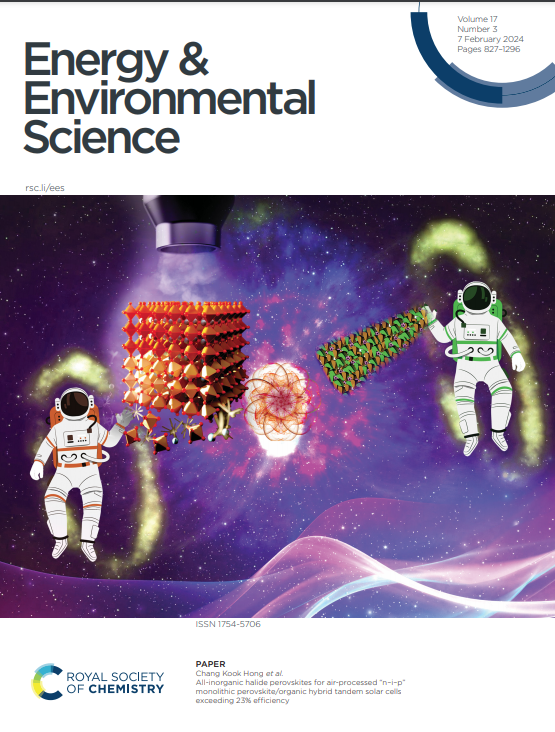Manipulating anion solvation competitiveness via a multifunctional additive toward robust low-temperature sodium metal batteries
IF 32.4
1区 材料科学
Q1 CHEMISTRY, MULTIDISCIPLINARY
引用次数: 0
Abstract
The kinetic conflict between accelerated Na⁺ desolvation and durable interphase construction remains a bottleneck for sodium metal batteries (SMBs) operating at low temperatures. Herein, we propose an electrolyte engineering strategy employing 0.20 wt.% pentafluoro(phenoxy)cyclotriphosphazene (FPPN) as a solvation-modulated additive, which concurrently optimizes Na+-desolvation energetics and directs self-assembling interphase architectures. Through precisely engineered coordination competition between PF6⁻ anions and diethylene glycol dimethyl ether (DG) molecules, FPPN promotes the formation of a bifunctional solid electrolyte interphase (SEI) comprising an ion-conductive NaF-dominant inner stratum and a mechanically resilient fluorocarbon outer layer. This hierarchically structured SEI enables spatially homogeneous Na⁺ flux distribution while maintaining exceptional interfacial cohesion. The derived cathode electrolyte interphase (CEI) exhibits superior anodic stability through anion-derived inorganic reinforcement. Consequently, the Na||Na symmetrical cell exhibits an extraordinary cycle life of 1400 h at -40 °C. When paired with Na3V2(PO4)3, the cell sustains an impressive 3300 cycles at 1 C and -20 °C. Even cycled at -40 °C, a high capacity of 60 mAh g-1 after 1750 cycles with a remarkable retention ratio of 98.00% can be realized. This work offers pivotal insights for designing electrolytes to achieve extended cycle life in low-temperature rechargeable metal batteries.通过多功能添加剂控制阴离子溶剂化竞争力,以实现坚固的低温钠金属电池
加速Na +溶解和持久的界面构建之间的动力学冲突仍然是低温下钠金属电池(smb)工作的瓶颈。在此,我们提出了一种电解质工程策略,采用0.20 wt.%的五氟(苯氧基)环三磷腈(FPPN)作为溶剂化调制添加剂,同时优化Na+脱溶能量和指导自组装间相结构。通过PF6毒毒剂和二甘醇二甲醚(DG)分子之间精确设计的协调竞争,FPPN促进双功能固体电解质间相(SEI)的形成,包括离子导电的naf主导的内层和机械弹性的氟碳外层。这种分层结构的SEI使得Na⁺的通量分布在空间上均匀,同时保持了异常的界面内聚性。衍生阴极电解质界面(CEI)通过阴离子衍生的无机增强剂表现出优异的阳极稳定性。因此,Na||Na对称电池在-40°C下具有1400小时的超长循环寿命。当与Na3V2(PO4)3配对时,电池在1℃和-20℃下维持了令人印象深刻的3300次循环。即使在-40°C下循环,经过1750次循环后,也可以实现60 mAh g-1的高容量,保留率达到98.00%。这项工作为设计电解质以延长低温可充电金属电池的循环寿命提供了关键的见解。
本文章由计算机程序翻译,如有差异,请以英文原文为准。
求助全文
约1分钟内获得全文
求助全文
来源期刊

Energy & Environmental Science
化学-工程:化工
CiteScore
50.50
自引率
2.20%
发文量
349
审稿时长
2.2 months
期刊介绍:
Energy & Environmental Science, a peer-reviewed scientific journal, publishes original research and review articles covering interdisciplinary topics in the (bio)chemical and (bio)physical sciences, as well as chemical engineering disciplines. Published monthly by the Royal Society of Chemistry (RSC), a not-for-profit publisher, Energy & Environmental Science is recognized as a leading journal. It boasts an impressive impact factor of 8.500 as of 2009, ranking 8th among 140 journals in the category "Chemistry, Multidisciplinary," second among 71 journals in "Energy & Fuels," second among 128 journals in "Engineering, Chemical," and first among 181 scientific journals in "Environmental Sciences."
Energy & Environmental Science publishes various types of articles, including Research Papers (original scientific work), Review Articles, Perspectives, and Minireviews (feature review-type articles of broad interest), Communications (original scientific work of an urgent nature), Opinions (personal, often speculative viewpoints or hypotheses on current topics), and Analysis Articles (in-depth examination of energy-related issues).
 求助内容:
求助内容: 应助结果提醒方式:
应助结果提醒方式:


